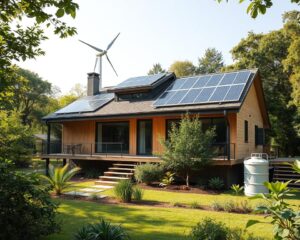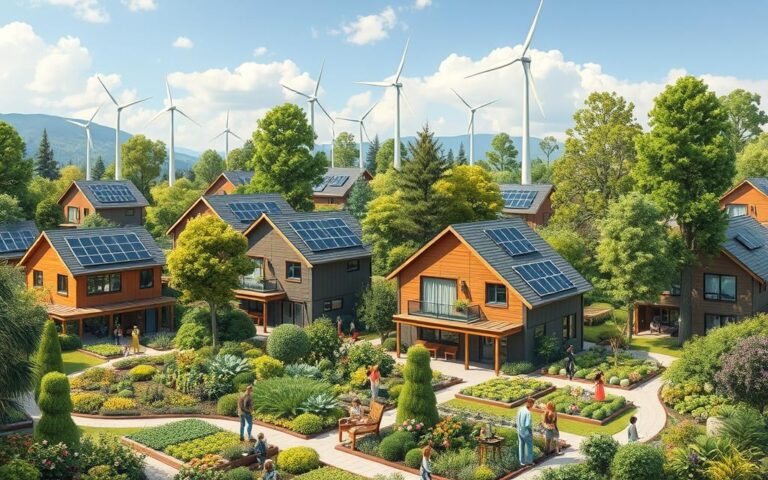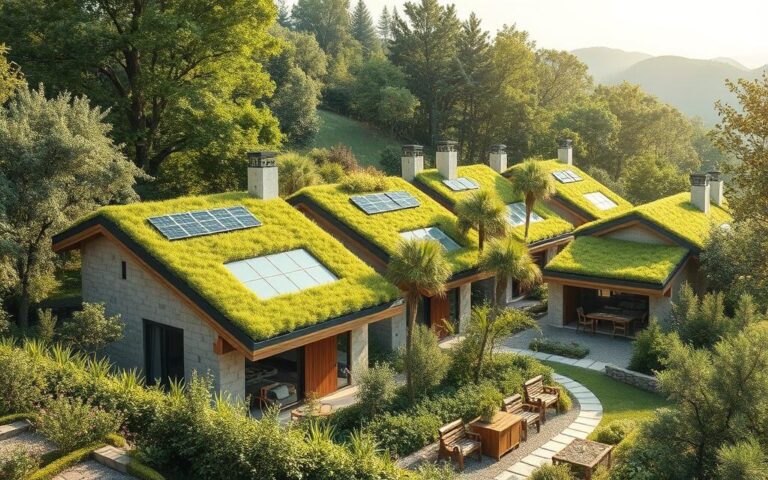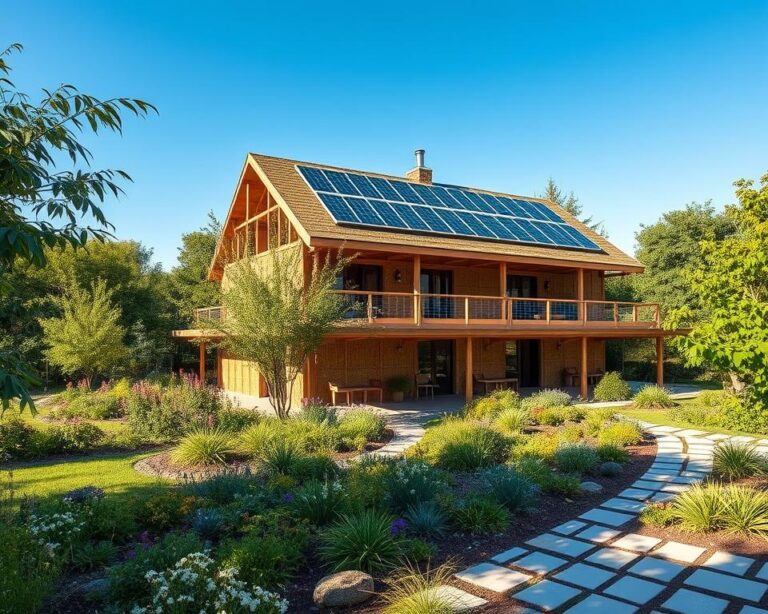Did you know over 80% of home buyers look for energy efficiency when buying a home? The need for renewable energy systems is growing fast. By adding eco-friendly power systems, you can make your home energy-smart and cut down on carbon emissions.
Technologies like solar, wind, and microhydropower are now easier to get. They help you save money on energy and help the environment. As homes become more sustainable, now is a great time to learn how renewable energy can help you and the planet.

Understanding Renewable Energy Systems
Renewable Energy Systems are a big step towards using energy in a way that’s good for our planet. They use natural resources like the sun, wind, and heat from the earth. This change is key to fighting climate change and keeping our energy supply steady.
What are Renewable Energy Systems?
Renewable Energy Systems include things like solar panels, wind turbines, and geothermal systems. These systems grab energy from nature and turn it into electricity or heat. In 2022, the U.S. made more electricity from renewable sources than from coal for the first time. This shows how reliable and important these technologies are.
The Importance of Renewable Energy
Renewable energy is vital because it helps us use less fossil fuels. It makes our energy supply safer and helps the environment. The U.S. has enough renewable energy to power the country over 100 times a year.
As clean energy tech gets better, we’ll see more solar and wind energy. Using these systems helps make our energy future cleaner and stronger.
Benefits of Renewable Energy for Your Home
Choosing renewable energy for your home brings many benefits. It saves money and helps the planet. Families using green energy cut their bills and make the Earth healthier.
Lower Energy Bills
Renewable energy systems can cut your energy costs a lot. With solar panels or wind turbines, you use less from the grid. This means lower bills over time, saving you money.
Increased Home Value
Homes with renewable energy systems are more valuable. Real estate agents see them as more attractive. This is because they are energy-efficient and appeal to eco-friendly buyers.
Environmental Impact Reduction
Switching to renewable energy helps the planet a lot. The electricity sector is a big source of global warming emissions. But, wind and solar energy are much cleaner, producing very little pollution. Using green energy reduces your carbon footprint and helps the environment.
Types of Renewable Energy Systems
Looking into different renewable energy systems can lead to sustainable energy for your home. Each system has its own benefits. They help you use less energy and protect the environment. Learn how solar, wind, and geothermal systems can change how you use energy.
Solar Energy Systems
Solar energy systems use the sun’s power to make electricity. They have photovoltaic panels that turn sunlight into energy. You can pick from monocrystalline, polycrystalline, or thin-film panels based on your needs and budget.
By adding solar panels and batteries, you can save a lot on your energy bills. You might save up to £525 a year.
Wind Energy Solutions
Wind energy solutions are another way to make clean electricity. They use wind turbines to turn wind into power. Wind power is a big part of renewable electricity in many places, including the UK.
Wind turbines are a key source of renewable energy in some areas. They show how wind power can be a reliable choice for green homes.
Geothermal Heating and Cooling
Geothermal systems use the earth’s heat for heating and cooling. They make your home more energy-efficient and save you money. By using the earth’s natural heat, these systems keep your home comfortable without relying on traditional heating.

Choosing the Right Renewable Energy System
Choosing the right renewable energy system for your home is important. You need to think about your energy needs, the space you have, and your budget. This will help you find the best renewable energy solutions for you.
Assessing Your Energy Needs
Start by looking at how much energy you use. Check your past year’s electricity use. Look for patterns or changes with the seasons. This will help you pick a system that meets your needs and saves you money in the long run.
Evaluating Space and Location
Your home’s location affects the best renewable energy choice. Some places are better for solar panels, while others are better for wind turbines. Think about how much space you have. Solar panels can go on roofs or be ground-mounted. Wind turbines need open areas with strong winds. Knowing this helps you choose the right system for your place.
Budget Considerations
Don’t forget about your budget when picking a renewable energy system. Costs vary based on the technology and local incentives. Many places offer rebates and tax credits to help. Remember, renewable energy can save you money on bills over time.
| Factor | Considerations |
|---|---|
| Energy Needs | Assess your average monthly usage; account for seasonal fluctuations. |
| Space Availability | Evaluate rooftops, land area, and suitable installation sites. |
| Location | Understand regional solar or wind viability based on local conditions. |
| Budget | Consider initial installation costs; check for incentives and rebates. |
| Long-term Savings | Calculate projected utility cost reductions and return on investment. |
By carefully considering these factors, you can choose the best renewable energy system. This will help you use sustainable energy and contribute to a greener future.
How to Install Renewable Energy Systems
Installing renewable energy systems can be done in two ways: hiring professionals or doing it yourself. Knowing the pros and cons of each method helps you choose the best option for you.
Working with Professionals
Working with certified professionals reduces the risk of errors during installation. They make sure everything follows local laws, giving you peace of mind. It’s wise to get quotes from at least three installers to compare prices.
Look for installers who are part of the Microgeneration Certification Scheme (MCS). This mark shows they meet government standards. Also, check if they are on the Competent Persons Register, which means they can self-certify their work.
When choosing an installer, make sure the deposit is reasonable. It should not be more than 25% of the total cost. Also, check if the deposit is insured.
DIY Installation Options
If you enjoy technical projects, you can install renewable energy systems yourself. Start by researching and planning carefully. This way, you can set up systems like solar panels or wind turbines at home.
Before starting, learn about local building codes and regulations. Keep all installation and maintenance records for future use. After finishing, get certificates like the Commissioning Certificate and MCS installation certification to prove your work’s quality.
| Method | Pros | Cons |
|---|---|---|
| Working with Professionals | Expert compliance with regulations Professional installation quality Less personal time commitment | Higher upfront cost Reliance on third-party schedules |
| DIY Installation | Lower cost potential Full control over the process Learn valuable skills | Requires technical knowledge Time-consuming Higher risk of errors |
Financing Your Renewable Energy Systems
Switching to renewable energy can be costly upfront. But, there are many ways to finance these systems. Government incentives and funding options can help lower the cost.
Government Incentives and Rebates
Government programs offer big incentives for renewable energy. The U.S. Department of Energy and the U.S. Environmental Protection Agency give tax credits and rebates. For example, the USDA offers loans of about $300,000, and HUD has energy efficiency mortgages.
These programs can make your initial costs much lower. They also encourage you to choose sustainable options.
Loan Options and Grants
Many banks offer loans for renewable energy projects. Freddie Mac, for instance, provides mortgages up to $240,000. PACE financing is another option, covering costs up to $50 million with lender consent.
Grants like the REAP program also help. They offer funding that doesn’t need to be repaid, covering up to 50% of costs.
Long-term Savings Calculations
Renewable energy systems save money on energy bills over time. Programs like Focus on Energy have helped businesses save over $3.5 million annually. By choosing renewable energy, you help the planet and save money.
It’s important to calculate these savings. This shows the real value of your investment.

Maintenance of Renewable Energy Systems
Keeping renewable energy systems in good shape is key to their success. Regular care makes sure they work well and last longer. A set maintenance schedule helps avoid big problems and saves money.
Routine Maintenance Tips
Here are some tips to keep your renewable energy tech running smoothly:
- Regularly check your systems for wear and tear.
- Keep solar panels clean to boost their performance.
- Watch how much energy your systems produce and how efficient they are.
- Look for any electrical or mechanical issues in wind turbines.
- For geothermal systems, check the heat exchanger and circulation pump often.
- Check the water levels in battery units if you have lead-acid batteries.
Recognizing and Addressing Issues
Catching problems early can save you a lot of hassle and money. Watch out for these signs:
- Unusual noises or vibrations in wind turbines, which can mean mechanical trouble.
- Lower energy output from solar panels, which could be due to dirt or damage.
- Leaks or discoloration in geothermal systems, which can hurt their performance.
- Systems tripping circuit breakers too often, which can be a sign of a problem.
New tech like vibration analysis, thermal imaging, and AI diagnostics makes fixing issues easier. Use these tools to keep your systems running at their best.
| Maintenance Task | Recommended Frequency | Key Benefits |
|---|---|---|
| Solar Panel Cleaning | Every 6 months | Improves energy output |
| Wind Turbine Inspection | Every 3 months | Prevents mechanical failures |
| Geothermal System Check | Annually | Ensures efficient functioning |
| Battery Water Level Inspection | Monthly | Extends battery lifespan |
Integrating Energy Storage Solutions
Energy storage solutions are key to making renewable energy systems more efficient. They let you save extra energy made when it’s plenty. This saved energy is used when you need it most.
These systems help manage energy well. This makes using renewable energy easier in our daily lives. It also supports green energy solutions.
Benefits of Energy Storage
Energy storage brings many benefits:
- Increased Energy Independence: You need the grid less because you can store energy for later.
- Resilience Against Outages: Your home can stay powered even when the grid goes down.
- Cost Savings: Using stored energy when prices are high can cut down your bills.
Types of Energy Storage Systems
There are many energy storage systems, each with its own features:
| Type of Energy Storage | Energy Capacity (kWh/MWh) | Descriptions |
|---|---|---|
| Lithium-ion Batteries | Varies, typically high capacity | Common electrochemical batteries used for residential energy storage. |
| Pumped Hydro Storage | Megawatt-hours | Long-standing system using water to store energy, though implementation can be slow. |
| Thermal Energy Storage | Megawatt-hours | Stores heat in fluids for later energy production. |
| Flywheel Systems | Short-term storage | Can quickly provide power but is limited in energy storage capacity. |
| Compressed Air Storage | Megawatt-hours | Utilizes pressurized air in large formations for energy production. |
| Solar Fuels | Varies | Energy sources like hydrogen produced from solar energy. |
As we need more renewable energy, energy storage solutions are more important. With better technology and lower costs, more homes will use energy storage. This is part of their renewable energy systems.
Smart Home Technology and Renewable Energy
Smart home tech and renewable energy change how we use energy at home. They make it easy for us to use clean energy every day.
Smart Meters and Energy Management
Smart meters help us manage energy better. They show us how much energy we use in real time. This lets us use more solar energy and less from the grid.
Using solar energy more can save us money on bills. It also helps reduce carbon emissions.
Automating Your Renewable Energy Use
Automation is key to getting the most from renewable energy. We can set smart appliances to use solar energy when it’s available. This cuts down on using traditional energy sources.
Smart security systems also use solar power. They make our homes safer and more energy-efficient. This helps the planet and keeps us comfortable.
With smart home tech and renewable energy, our homes can use solar energy better. More people want to live greener, making our homes more valuable and energy-independent.
| Feature | Benefits |
|---|---|
| Smart Meters | Real-time energy tracking, cost reduction |
| Automated Appliances | Energy efficiency, convenience |
| Smart Security Systems | Enhanced safety, energy use optimization |
| IoT Integration | Device connectivity, precise energy management |
This way of managing energy makes our homes more efficient, sustainable, and comfortable. With renewable energy, the future of home management looks bright.
Case Studies: Successful Integration Examples
Many case studies show how renewable energy works well in different places. Looking at these examples can teach us a lot. They show how homes and communities can use sustainable energy.
Homeowner Experiences
Homeowners have started using solar panels and wind turbines. This has saved them a lot of money and even made their homes more valuable. In the ERCOT area, adding the first 10,000 MW of wind energy cut energy costs by about $0.50 per MWh.
This shows how technology and community help. It lets homes play a big part in using more renewable energy.
Community Initiatives
Community projects show how working together can help. Reykjavik in Iceland gets over 85% of its electricity from green sources. Portugal went 149 hours without using fossil fuels, thanks to renewables.
In Uruguay, almost 98% of electricity comes from clean sources. These efforts show how together, we can make a big difference. They also teach us about taking care of our planet.
| Country/Region | Renewable Source | Percentage of Electricity from Renewables |
|---|---|---|
| Iceland | Hydropower, Geothermal | 85% |
| Portugal | Various | 100% for 149 hours |
| Uruguay | Wind, Solar, Hydro | 98% |
| Global (2023) | Multiple Sources | 50% increase in capacity |
Future Trends in Renewable Energy for Homes
The future of renewable energy is exciting, with new technologies on the horizon. Solar and wind power are growing fast, with solar seeing an 88% jump in 2024. This shows that renewable energy is getting better and easier to use.
Advanced solar panels and new battery systems are leading the way. They help homes use less fossil fuel and become more energy independent. This is a big step towards a greener future.
Emerging Technologies
Electric vehicles are changing how we think about energy at home. Utilities are using more battery storage to handle extra wind and solar power. This means homeowners can enjoy better energy flow thanks to new tech.
More homes are turning to solar power, aiming for 25% of homes to do so soon. This move towards sustainability is good for the planet and our energy needs. By keeping up with these trends, you can help create a greener future for your home.
Renewable energy is not just about cleaner energy sources. It’s about using technology to protect our planet and our homes. By investing in solar power and smart grids, you’re leading the way in the clean energy movement.
FAQ
What are Renewable Energy Systems?
Renewable Energy Systems use natural resources like sunlight, wind, and geothermal heat to make energy. They turn endless resources into power we can use. This helps us use less fossil fuels.
Why is integrating renewable energy important for homeowners?
Using renewable energy at home cuts down on carbon emissions and saves money on bills. It also makes your home more valuable. Plus, it helps protect the environment, fitting into the trend of living sustainably.
What types of renewable energy systems are available for home installation?
You can choose from solar, wind, and geothermal systems for your home. Each has its own benefits and works best in different places and for different needs.
How can I assess my energy needs for a renewable energy system?
Look at how much energy you use now, how much space you have, and where you live. Knowing this helps pick the right renewable energy for you.
What financing options are available for installing renewable energy systems?
There are federal and state incentives, rebates, loans, and grants to help pay for renewable energy systems. These options make it easier to get clean energy technology.
How do I maintain my renewable energy system?
Keep it running well with regular checks, clean panels, and watching its performance. Each system needs different care to work its best.
What are the benefits of energy storage solutions when using renewable energy?
Energy storage lets you save extra energy for later. It helps manage your energy use when it changes. This makes you more independent from the grid.
How can smart home technology enhance the use of renewable energy?
Smart home tech lets you watch your energy use in real time. Automation tools make your systems work better, making energy use more efficient and green.
Can you provide examples of successful renewable energy integration?
Yes, many homeowners have successfully used renewable energy. There are also community projects that show how to work together for a greener future.
What emerging technologies should homeowners be aware of in renewable energy?
Keep up with new solar panels, smart grids, and energy storage. These new techs are making energy use cleaner and more efficient.




